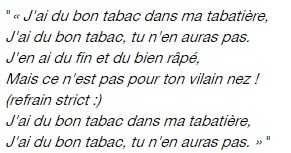Interesting to the slattery, this accessory of tobacco,I discovered that the story of this object was also part of Brittany, my region, in the tradition of the porcelain factory. This object has taken almost all forms and has been manufactured by all materials. So much to sniff and stuff his pipe, thisold box found several uses. In the eighteenth century, the object promised to distinguish itself with elegance, to the point of lending to tobacco medicinal virtues. The object thus tells a part of our history. I invite you to a smoker story.

CREATIONACC leather snuffbox
|
Summary 1. The different names of the tobattery |
The different names of tobathers
The sales and antique shops see a lot of "Snuff Box", which literally means box to sniff. Thus the English term for slattery indicates that the main use of this accessory is not the one we think. Neither to smoke cigarettes nor to pull on her pipe, the powder was stored there was "sniffed" by the nose. The tobacco joke or the pipe kit are rather reserved for the use of burning tobacco finally. Among the oldest, some have a special form: the shaking is also called "Toute" (term Normand) or "petitan" (from "Petun" who in spoken language became Petuier, which means tobacco). Specialists, including collectors (buxidanicophiles) will say that there are also terms for each form.
In porcelain, leather and other materials

Pipe smoker metal box
One finds in corozo nuts, in tin, ivory, terracotta (in Normandy especially), glass, iron, in porcelain, obviously in leather As at Creationacc, fabric, wooden wood, even in birch bark, brass and even in shell or horn .... The list of materials is endless.
in tin, ivory, terracotta (in Normandy especially), glass, iron, in porcelain, obviously in leather As at Creationacc, fabric, wooden wood, even in birch bark, brass and even in shell or horn .... The list of materials is endless.
This is where we find the explanation of the origin of the name given to its collectors:Buxidanicophiles.The word derives directly from a Latin term that means boxwood box: "Buxida". The same boxwood that serves to the pipes (see our article on The manufacture of pipes) is used in the first tobacco boxes, towards the 17th century.
The form of the oldest

Horny
It did not always have the form of a box with a lid. The oldest had the shape of a pear with a hole at their end, closed with a cork cork. To use and extract the powder, it was necessary to shake. They were therefore called shaking. We find mainly in Brittany, especially in the nineteenth century. Many models survive us because made of porcelain by the quimper factory. Auctions regularly offer shaking, up to this TV show in 2019, "Conclude case". It also learns that sailors preferred the shake to tobacco jokes.
The pear shape of the shares is not systematic. Sometimes she took the form of characters.
It is also found in the shape of a Ster-Jacques shell in solid silver under Louis XV.
A class elevation accessory

Noble sniffant tobacco
It is undeniable that in the 18th century, going out and manipulating a tobacco box on the road gave you the insurance of the high classes of the company. Question of means So, the first smokers were noble. At that time, the boxes being used by snouts. We do not speak yet of smokers. Often used for tobacco sniff, prize, we also gave medicinal virtues to the powder that we were stored there.
I did not find the origin of the expression "to be prized", but to think about it, it is not excluded that there is a link: remember that prize means "give prize", "enjoy", "enjoy", "appreciate" "Estimate" ..... we can say that the tobattery was popular with the bourgeois.
A binder now finds this easily this smoking accessory, dating mainly from the eighteenth century. Noble materials like ivory, it has thus been less degraded.
Song
At the beginning of the eighteenth century that popular art appropriates the object in the famous song "I have good tobacco in my tablatiar". Popular song that accompanies a period object.
Words :


Classic music lovers may have heard a day of the Russian composer Anatole Liadov, little played alas, "musical snuffbox" in the major op. 32, a snuffbox in French.
The accessory and the soldier

Gauloises Corporal
Precious, the accessory has become common, until it is part of the soldier's package during the world wars, but also on the previous ones.
A site on the lighters of the hairy, which also talks about military topass, from the nineteenth century. We see Napoleon in 1910 with his tobattery. : https://briquets-poilus.skyrock.com/3292493904-BRIQUET-ARTISANAL-Secouette.html
The boxes also contained tobacco (tobacco that does not smoke but chic).
An interesting site on tobacco accessories in the army: http://www.symbols-et-traditions.fr/articlesMembers/targui/tabac-accessories/page-tabac.htm
 any question ?
any question ? 

